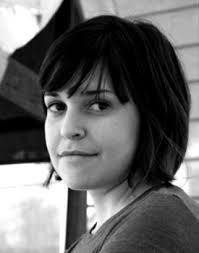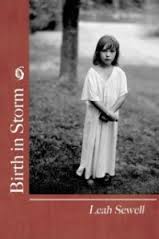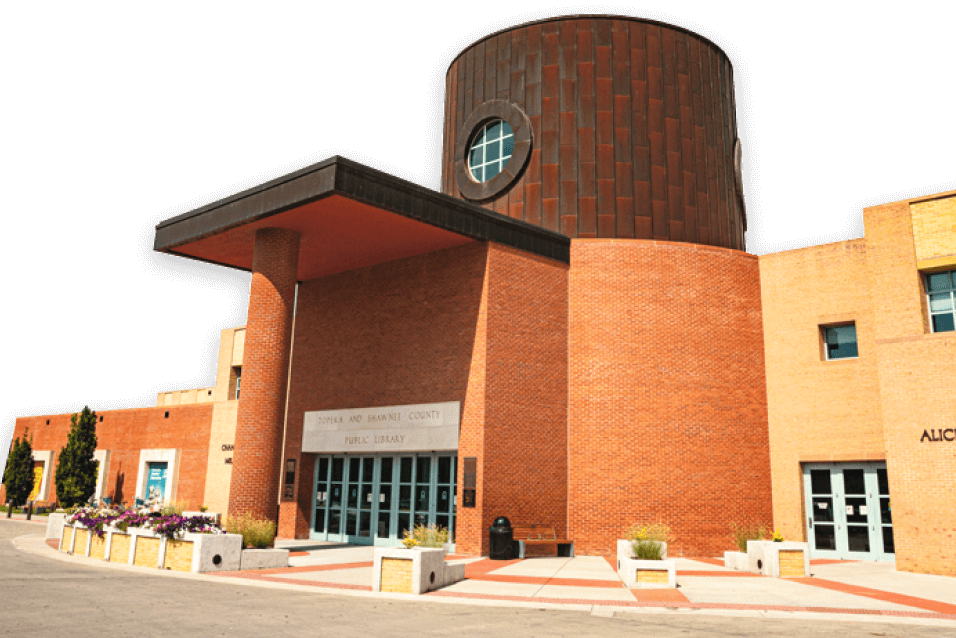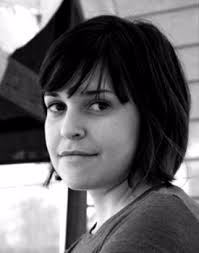An Interview with Topeka Poet Leah Sewell
 Leah Sewell's debut collection, Birth in Storm, evokes haunting images that draw readers back for frequent rereading, with striking sound quality that invites us to read aloud and savor the syllables.
Leah Sewell's debut collection, Birth in Storm, evokes haunting images that draw readers back for frequent rereading, with striking sound quality that invites us to read aloud and savor the syllables.Sewell has made a name for herself in Topeka as a woman of immense talent and creativity. She won the 2010 Women Making Headlines Award in the media category from the Topeka Chapter of the Association of Women in Communications, and has been a recipient of the PenWomen Award for Letters. She was the editor-in-chief of Topeka’s arts and entertainment magazine, seveneightfive, for five years. She was also the founding editor of Topeka family and lifestyle magazine, XYZ, and was co-owner of the magazine from 2013-2014. She also works as a freelance graphic designer, with over a dozen poetry and prose book covers to her credit.
 Sewell’s poetry has appeared in Magazine, Rufous City Review, Weave Magazine, Flint Hills Review, Inscape, Midwestern Gothic, Mochila, Stone Highway Review and other journals. Her poems have also been anthologized in Begin Again: 150 Kansas Poems and To the Stars Through Difficulties: A Kansas Renga in 150 Voices. Her poem “The Crimson Lady” was nominated for a Pushcart Prize in 2012, and in 2013 she won the Emerge Publications Chapbook competition for her first collection, Birth in Storm. She is currently a candidate for a Masters of Fine Arts in Poetry from the University of Nebraska.
Sewell’s poetry has appeared in Magazine, Rufous City Review, Weave Magazine, Flint Hills Review, Inscape, Midwestern Gothic, Mochila, Stone Highway Review and other journals. Her poems have also been anthologized in Begin Again: 150 Kansas Poems and To the Stars Through Difficulties: A Kansas Renga in 150 Voices. Her poem “The Crimson Lady” was nominated for a Pushcart Prize in 2012, and in 2013 she won the Emerge Publications Chapbook competition for her first collection, Birth in Storm. She is currently a candidate for a Masters of Fine Arts in Poetry from the University of Nebraska.Read on for an original interview with one of Topeka's most talented writers.
Miranda Ericsson interviewed Leah Sewell via email in October, 2013When did you start writing poetry? What authors and poets have influenced your work?
I started writing poetry as a child — I liked to make gifts of cards with little poems in them or write little rhyming poems, but I always considered myself a fiction writer, and wrote short stories and even attempted novels beginning in third grade! I was misinformed that poetry required rhythm and meter — things that seemed a little daunting when coming to the page —and so I mainly stayed away from it until my freshman year of college when I met a fantastic poet and a woman who became my teacher and mentor, Amy Fleury. Her enthusiasm for poetry and her method of teaching the craft convinced me to take the genre seriously, and I found myself becoming obsessed with writing poetry, thinking like a poet, and reading copious amounts of poetry for the first time in my life. I think my roots in narrative, in fiction, have filtered through my poetic work. I think of myself as a narrative-centered rather than lyrically-centered poet, although my work can contain elements of both. I still harbor dreams of writing a novel someday — when I can find the time!
I have been influenced by some incredible mentors throughout my education — Amy Fleury, as I mentioned, Allison Hedge Coke, Teri Grimm, and Lee Ann Roripaugh — all wonderful poets whose work I admire, but who also have guided me in interpreting poetry and living like a poet, that particular way of understanding the world and transforming observation into something musical, evocative, and meaningful.
I deeply appreciate the work of Sharon Olds, Sexton and Plath, Frank Stanford, Elizabeth Bishop, Adrienne Rich, Louise Glück, and Muriel Rukeyser to name a few. I also admire the work of Natalie Diaz, Mary Ruefle, Gina Myers, Talvikki Ansel, Jan Beatty, Joy Harjo, Patricia Smith … I could go on. I’m an avid reader! I think that every book I read ultimately influences me. Subconsciously or no, I’m gathering devices and learning new things about language.
Tell us about your connection to Kansas. Has living here influenced you as an artist and writer?When I visit home , my family makes fun of my “southern accent.” I’ve lived in Kansas for over a decade, and I think of Topeka, Kansas as my acquired hometown. If my accent has been transformed away from the Polish-tinged, cutting consonant-laden dialect of Chicago to tend more toward the drawn-out vowels and slower-pace of Kansas in ways that are noticeable by my family, I can only imagine the ways this place has affected me internally!
I don’t think of myself as a “Kansas writer,” but it’s interesting the ways the place has evidenced itself in my work. When my chapbook, Birth in Storm, was in pre-press earlier this year, I asked a friend to write a blurb for the back cover. What he said in the blurb — a line about my poetry “speaking the language of the plains” — surprised me. But the more I thought about it, the more I began to realize that I’ve really realized myself in Kansas, found my voice here, became essentially the person I am today while in this setting, and I’m sure I’ve internalized a lot about the place that comes out in my work. I am particularly inspired by weather, and by storms, and find the natural world and its unpredictability to be wonderful grounds for metaphor. Kansas is the perfect locale to observe natural phenomena. Here I feel especially attuned to nature, to the electricity and potential danger of the storm seasons, to the encroachment of prairie surrounding my town, to the oppressive nature of both summer and winter, when weather extremes invite introspection and imagination.
An earlier version of your poem “Astra” appears on the 150 Kansas Poems website, titled at that time as “To the Stars Through Difficulty.” Though both describe birth in storm, the online version is a substantially different work than the poem that was published in your collection. The final version is clearer, more vividly sensory, and more aurally pleasing. You turned a good poem into a striking poem through revision. Tell us a little about your writing process. Is it typical for one of your poems to change a great deal from start to finish? Do you have any tips for revision to share?When I originally wrote “Astra,” it was under certain constraints – it was a part of the Kansas Renga project, with the guidelines being that I should write a ten-line poem in response to what the Renga writers before me were previously writing, or as a continuation of that writing. It was also under a time constraint; I had a small window of time to write the poem and a deadline to adhere to. But it’s a good example of how my revision process typically pans out, because each time I sit down to write a poem, I am under certain constraints: I have a particular and maybe narrow frame of mind at the writing-time, I have, perhaps, an idea I’m hoping to flesh out, and maybe I have only an hour or so to write the poem before I have to do some other task. With “Astra,” I was able to dissolve all those former constraints with my revision and let the poem breathe and become once again pliable in my hands. The basic genesis was still there, but now I had some distance. I really feel that distance from the poem is a great first step in the revision process. I tend to think that my best poem is the one I just finished writing. Then a month or two later I look back at it and think, this poem could be better, so it’s easy to sculpt the basic idea – the thing the poem is trying to say – more successfully without feeling like you’re doing an injustice to the poem’s original thrust.
As far as my writing process, I think I tend to get very excited over series of poems – poems that seem to navigate around a common thread – and will generate many poems over a relatively short period. I am in no way a rigorous or disciplined writer; I write when I feel like writing, which, in a fertile period, can be a lot. But when the writing is coming slow or doesn’t feel inspired, or I find myself too busy with other life things, I don’t kick myself for not writing more. I do try to journal or write something during those periods, even if it’s a list of ideas for poems or a list of words or phrases.
You were the founding editor of XYZ, a popular Topeka magazine for families, and a current co-owner and art director. You also work as a freelance graphic designer for magazines and books. Your flair for the visual is apparent in your highly imagistic poetry. Does creating visual art inspire your writing? Does the written word inspire you as a graphic designer?This is a difficult question! I actually don’t feel like my work as a designer and my work as a writer are connected in any obvious way. When I was a kid, I wanted to be a visual artist, and I was very interested in art, so I think of my design work as a continuation of that part of myself. There’s another part of myself that feels compelled to tell stories or play with language – so, I guess I think of them as separate. I do feel, as a poet, a stronger duty to portray the work of other poets in their books in an aesthetically pleasing way. In my work as assistant editor with Coconut Books, and with freelance work for Kansas presses, I have been blessed to create titles for poets whose work I admire so much, and I think being a poet and having a sensibility toward poetry has helped me to create books that are representative of each poet’s personal aesthetic and style.
And working on magazines is just this inexplicably fun thing I get to do—I have no idea how it connects to my writing other than it sometimes requires me to write outside my usual tone and style, which is always a good thing. I love working in publishing. I feel a strong affinity for it, and know that it dovetails quite well with my ambitions and work as a writer.
Tell us about the Topeka Writer’s Workshop. What led you to found this group, and how has it supported you as a writer?When I was finished with my undergrad and taking care of my very young daughter, I experienced a kind of dry spell in my writing where each rare poem felt like an agonizing process, and I was pretty uninspired and frustrated with my own writing. Right after my son was born, I decided to join a writers workshop at the Lawrence Arts Center, which was the only thing to my knowledge that was available as a place for writing exercise and feedback in the area at the time outside of Washburn (this was 2009). So I’d drive over to Lawrence every week and participate in this workshop, and it was really great, but I couldn’t easily access the writing community in Lawrence outside of the weekly meeting. I didn’t feel like an integrated part of that community. So over the next few months I started talking with Topeka writers about forming our own group, and in July of 2009, we had 25 people show up to the first meeting. It was totally unruly, and a lot of work! Over the years I’ve fine-tuned the process and whittled down the membership to a level where people can feel like their work is getting due attention. The Workshop is one thing I do that never, ever feels like an obligation. It is always a pleasure, and because it is something of my own making and is comprised of very close, dear writer-friends, it can wax and wane in levels of intensity depending upon the other things that are going on in my life or the lives of the other members. We’ve done readings and public workshops in the past and will continue to do more in the community with this current core group of eight members and as we continue to collect more impassioned and dedicated writer-peers from the Topeka area. Being a part of this tight-knit community has done wonders for me; I am grateful for their attention to my writing and I also love supporting and championing the work of my friends. It is so beneficial to feel like you are part of a greater whole, to not feel like you are writing inside a void.
Your poem, “Crimson Lady,” was nominated for a pushcart prize in 2012, and your collection, Birth in Storm, won the 2013 Emerge Publications Chapbook Competition. Have these successes eased your path in subsequent publishing efforts? Do you face new challenges due to the increased attention to your work?I am honored to have achieved these successes, but I don’t feel that a great change has occurred since then. I am still faced with the blank page that I personally must fill with words, and my work oftentimes still needs quite a bit of attention and rigorous revision before I consider it fit to send out for possible publication, and I still receive my fair share of rejections. The greatest challenge I’ve encountered has been the necessity to promote my book or myself via readings, etc., which isn’t really my thing—I don’t like to draw a lot of attention to myself, but it’s actually a very important part of publishing if I ultimately want a lot of eyes on my work. And, of course, like any writer, that’s the goal – to be able to share your vision and imagination with others.
You are currently an MFA candidate. Is the program changing the way that you write? Are you compiling poems for a new collection? Tell us a little about your writing plans for the next few years.Yes! The wonderful MFA program at University of Nebraska Omaha is helping me to change the way I write—most noticeably the sheer mass of poems I’m creating each semester! The program culminates in a creative thesis of a complete collection of poems, so I’m working toward that, learning to sculpt my poems into the best shape they can be, writing critically about other works and reading a ton. I also have made connections with so many more writers through the program, widening the scope of my writing community, and forming connections that I feel will last a lifetime. I will be finished with my MFA in July of 2014, and after that I believe I will continue working in design and publishing, working on my own poetry with the eye toward publishing a full-length collection and possibly looking into teaching opportunities.
How can readers find out more about you and follow your work?I have a website now, which I try to update occasionally: leahsewell.com
My tumblr is another occasional place of mine online, which I tend to use in focus on my book and design work: lsewell.tumblr.com
And, I’m on Goodreads.
Learn more about Leah Sewell, and other Kansas authors, on the Map of Kansas Literature, a growing database of Kansas authors built by Washburn University and the Center for Kansas Studies.
You can check out episode 51 of our library's HUSH Podcast to hear two poems by Leah Sewell. You'll also hear about the work of Kansas writers Thomas Fox Averill, Israel Wasserstein, Laura Moriarty, Kij Johnson, and Eric McHenry.
Visit your Topeka and Shawnee County Public Library to check out a copy of Birth in Storm (2013). You can click the cover below to see the catalog listing or place a request.














